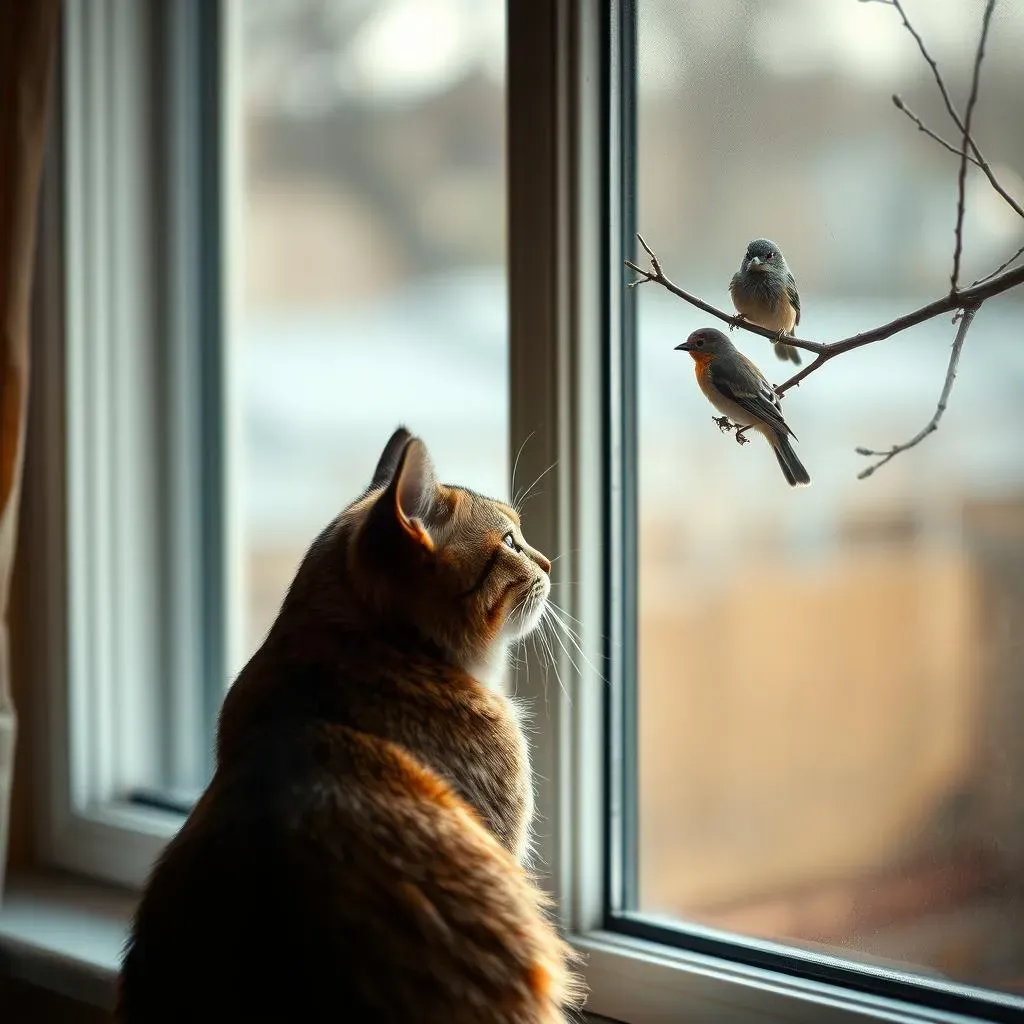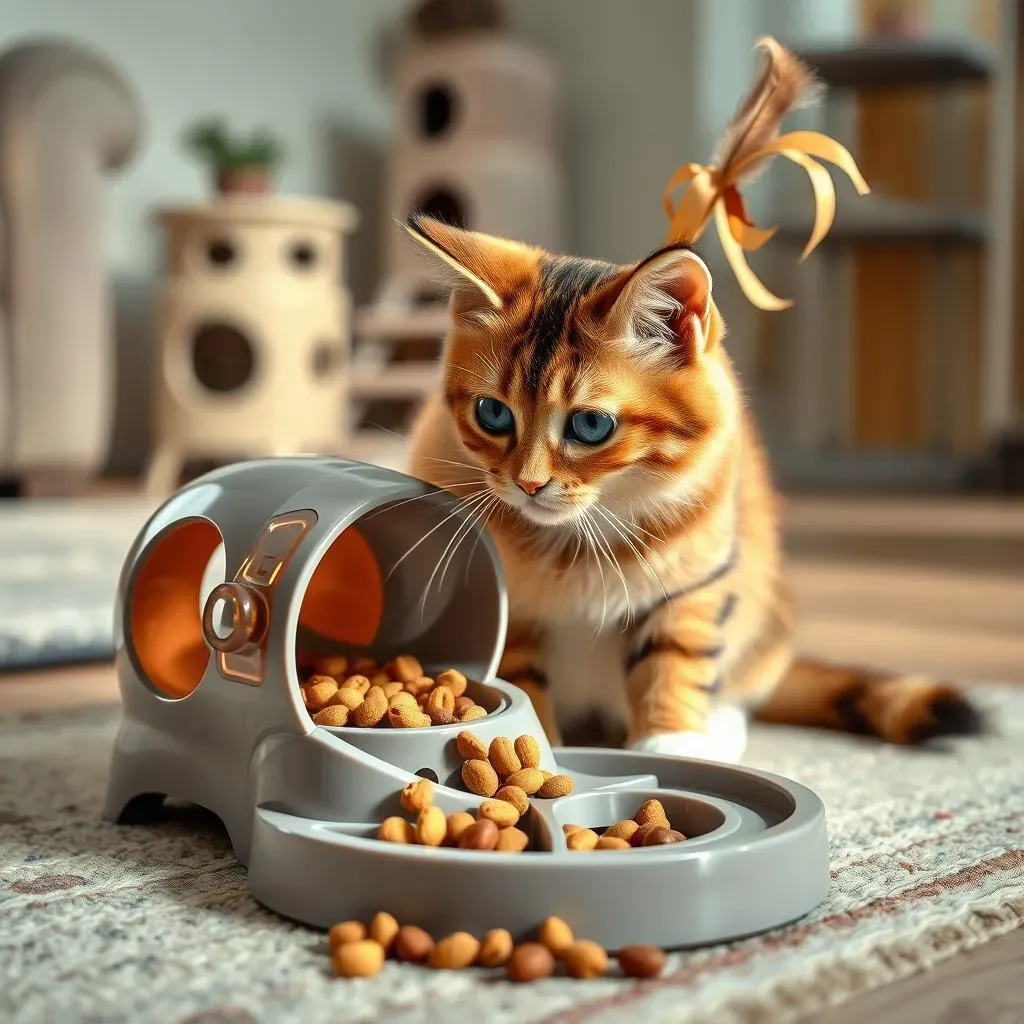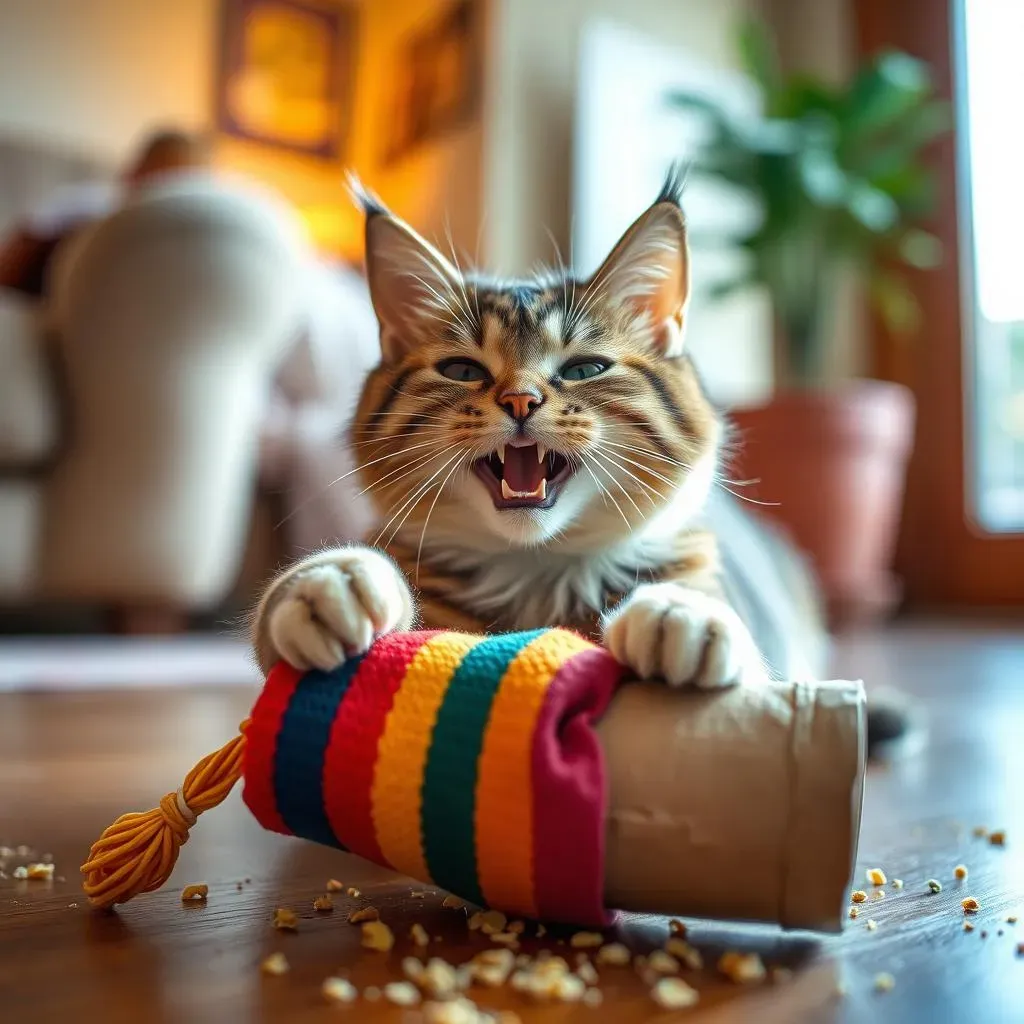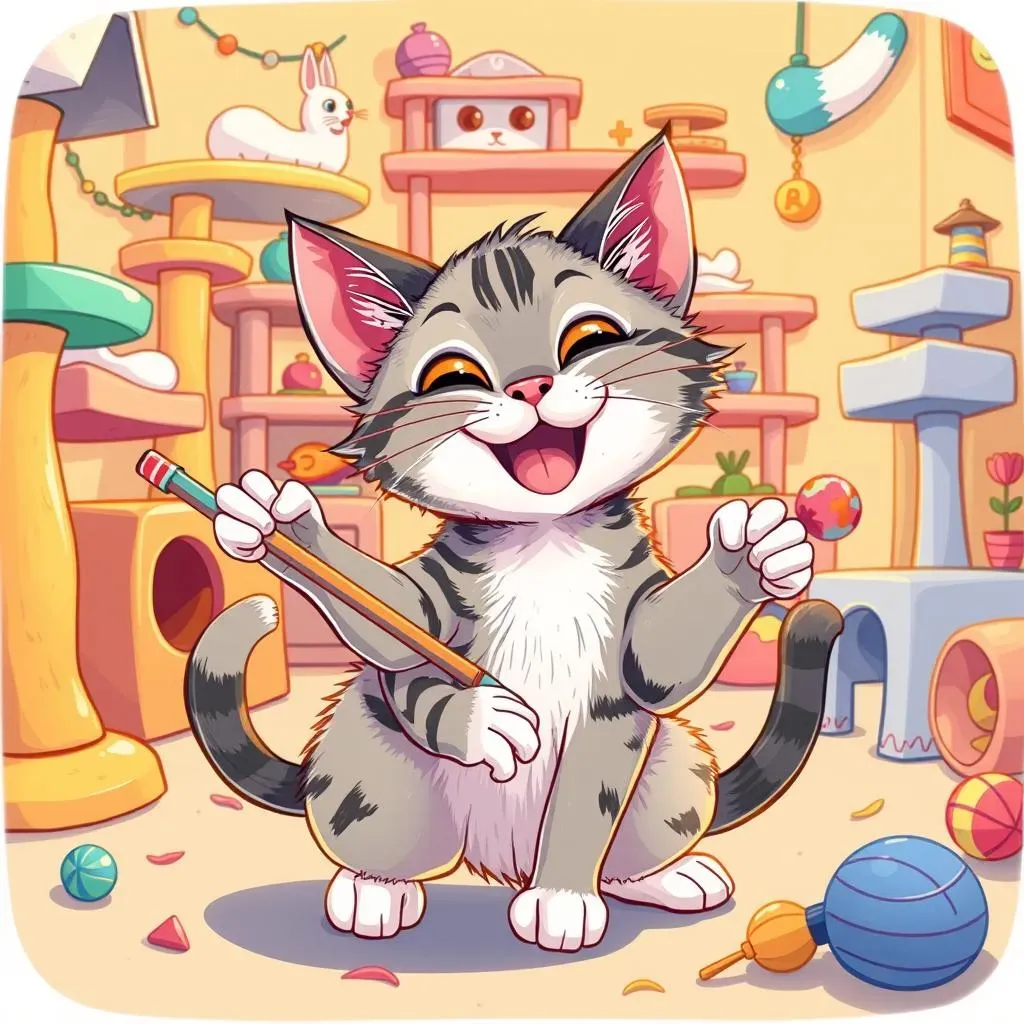Table of Contents
Does your indoor cat spend most of its day napping, only to unleash a flurry of chaotic energy at 3 AM? You're not alone! Many indoor cats experience boredom due to a lack of stimulation, which can lead to destructive behavior, overeating, and even depression. But fear not, fellow cat lovers! The solution is simpler than you think: engaging toys. This guide dives into the world of the best cat toys for bored indoor cats, offering a curated selection of products and DIY ideas to keep your feline friend entertained, active, and happy. We'll explore why indoor cats get bored, highlight top toy options, provide instructions for creating your own affordable toys, and share tips for interactive play. Get ready to transform your cat's environment and say goodbye to boredom-induced mayhem!
Why Indoor Cats Get Bored (and Why It Matters)

Why Indoor Cats Get Bored (and Why It Matters)
The Confined Life: A Mismatch with Instinct
Indoor cats, bless their furry little hearts, face a unique challenge. They're essentially living a life that's at odds with their natural instincts. Think about it: their wild ancestors spent their days hunting, exploring, and marking their territory. Now, our domesticated pals are often confined to four walls, a comfy couch, and a food bowl that magically refills. It's like putting a race car driver behind the wheel of a parked car – the potential is there, but the outlet isn't.
This mismatch between instinct and environment is a primary driver of boredom. Without the opportunity to engage in natural behaviors, cats can become restless, frustrated, and even develop behavioral problems. It's not just about physical activity; it's about mental stimulation, too. A bored cat is an understimulated cat, and that can have serious consequences for their well-being.
Consequences of Cat Boredom: More Than Just Zoomies
so your cat is bored. What's the big deal? Well, it's more than just the occasional case of the zoomies at ungodly hours. Chronic boredom can manifest in a variety of negative ways. Some cats become destructive, scratching furniture, knocking things off shelves, or even engaging in aggressive behavior. Others may overgroom, leading to bald patches and skin irritations. And then there's the emotional toll: boredom can contribute to anxiety, depression, and a general decline in quality of life.
It's easy to dismiss these behaviors as "just being a cat," but often, they're cries for help. Your cat is trying to tell you, in the only way they know how, that they need more stimulation. Ignoring these signs can lead to a downward spiral of unhappiness and unhealthy habits. Recognizing the consequences of boredom is the first step in creating a more enriching environment for your feline companion.
Boredom Symptom | Potential Consequence |
|---|---|
Destructive Scratching | Damaged furniture, frustration for owner |
Overgrooming | Skin irritation, hair loss |
Aggression | Injuries to humans or other pets |
Lethargy/Depression | Reduced quality of life, potential health issues |
Environmental Factors: The Indoor-Only Challenge
Let's face it: the typical indoor environment isn't exactly a thrill-a-minute for a cat. Many homes lack vertical space, hiding spots, and opportunities for exploration. A single scratching post in the corner and a window perch just don't cut it for a creature designed to climb trees, stalk prey, and survey their domain. The lack of environmental enrichment is a major contributor to boredom in indoor cats.
Consider the difference between a cat who spends their days hunting mice in a barn and a cat who spends their days lounging on a sofa. The barn cat is constantly engaged, using their senses and skills to survive. The sofa cat, on the other hand, is relying on you to provide all the stimulation they need. Creating a more stimulating indoor environment is crucial for combating boredom and promoting your cat's overall well-being. Think vertical space, interactive toys, and opportunities for exploration. It's about transforming your home into a feline paradise, one scratching post at a time.
Top Toys to Combat Boredom in Indoor Cats

Top Toys to Combat Boredom in Indoor Cats
Interactive Feeders: Turning Mealtime into Playtime
Let's be honest, a bowl full of kibble isn't exactly the most stimulating dining experience. Interactive feeders, on the other hand, transform mealtime into a puzzle-solving adventure. These toys require cats to work for their food, tapping into their natural hunting instincts. From puzzle bowls to treat balls, the options are endless. Not only do interactive feeders combat boredom, but they also help prevent overeating by slowing down your cat's consumption. It's a win-win!
Consider a puzzle bowl with various compartments and obstacles. Your cat will have to use their paws and nose to maneuver the kibble out of the maze, providing both mental and physical stimulation. Or, try a treat ball that dispenses food as it's rolled around. This encourages your cat to be active and engaged, turning a mundane meal into a fun and rewarding activity. Forget the boring bowl, embrace the interactive feeder revolution!
Wand Toys: Unleash the Inner Hunter
Ah, the classic wand toy. Simple, yet incredibly effective. These toys consist of a wand with a string or attachment (feathers, ribbons, etc.) that you can use to mimic the movements of prey. The key is to be engaging and unpredictable, making the "prey" dart, flutter, and hide. This taps into your cat's hunting instincts, providing a satisfying physical and mental workout. Plus, it's a great way to bond with your feline friend!
Experiment with different types of attachments to see what your cat prefers. Some cats are obsessed with feathers, while others prefer ribbons or crinkly toys. Vary the speed and movement of the wand to keep your cat guessing. Remember, the goal is to simulate a real hunt, so don't make it too easy! A few minutes of interactive play with a wand toy can make a world of difference in your cat's overall well-being. Just be sure to put the wand toy away when you're done, to prevent your cat from chewing on the string and potentially ingesting it.
Toy Type | Benefits | Considerations |
|---|---|---|
Feather Wand | Simulates bird prey, encourages jumping | Feathers can be fragile, supervise play |
Ribbon Wand | Provides visual stimulation, easy to maneuver | Ribbons can be ingested if chewed |
Laser Pointer | Encourages chasing, provides exercise | Avoid shining in eyes, end with a tangible reward |
Scratching Posts and Pads: Satisfying the Scratching Urge
Scratching is a natural and essential behavior for cats. It helps them maintain their claws, stretch their muscles, and mark their territory. Providing appropriate scratching surfaces is crucial for preventing destructive scratching on your furniture. Scratching posts and pads come in a variety of materials and styles, from sisal-covered posts to cardboard scratchers. Finding the right one for your cat may take some experimentation, but it's well worth the effort.
Consider the placement of your scratching posts. Cats often like to scratch after waking up or before settling down for a nap, so placing a post near their favorite sleeping spots can be effective. You can also try sprinkling catnip on the scratching surface to entice your cat to use it. Remember, scratching is a natural behavior, so provide your cat with appropriate outlets and save your sofa from becoming a scratching casualty.
DIY Cat Toys: Fun and Affordable Options

DIY Cat Toys: Fun and Affordable Options
Sock It to 'Em: The Ultimate Sock Toy
Got old socks lying around? Don't toss 'em! They're a goldmine for DIY cat toys. The simplest sock toy involves stuffing a sock with catnip, crinkled plastic bags (for that irresistible crunchy sound), or even other old socks. Tie off the end, and voila! You've got a durable and engaging toy that your cat will love to bat around, bunny-kick, and generally terrorize. For extra flair, tie a few knots along the sock or attach feathers or ribbons to the end. Just make sure any attachments are securely fastened to prevent your cat from swallowing them.
Want to level up your sock game? Try making a sock octopus! Stuff a sock as described above, then cut the open end into strips to create tentacles. Tie off each tentacle, and you've got a multi-textured toy that's perfect for wrestling. The beauty of sock toys is that they're easily customizable and endlessly replaceable. When one gets too worn or slobbered on, simply whip up a new one! It’s cheap, easy, and cats adore them, making it a go-to for budget-conscious cat owners.
Cardboard Creations: Boxes, Tubes, and More!
Cardboard: it's not just for shipping! Cats are naturally drawn to cardboard boxes, and for good reason. They provide a sense of security, a place to hide, and an irresistible scratching surface. A simple cardboard box can be transformed into a feline fortress with a few strategic cuts and some creative decorating. Cut out windows and doors, create tunnels by connecting multiple boxes, or even build a multi-level cardboard condo. The possibilities are endless!
Cardboard tubes, like those from paper towels or toilet paper, are also great for DIY cat toys. Simply fold in the ends to create a closed tube, then cut holes along the sides. Toss in a few treats or kibble, and let your cat figure out how to get them out. This provides both mental and physical stimulation, keeping your cat entertained for hours. Just be sure to remove any staples or tape before giving the tube to your cat. With a little imagination, cardboard can become your cat's new favorite playground.
DIY Toy | Materials | Instructions | Benefits |
|---|---|---|---|
Sock Toy | Old sock, catnip, crinkle material | Stuff sock, tie off end | Durable, customizable, affordable |
Cardboard Box Castle | Cardboard boxes, scissors, tape | Cut holes, connect boxes | Provides hiding spots, scratching surface |
Treat Tube | Cardboard tube, scissors, treats | Fold ends, cut holes, insert treats | Mental and physical stimulation |
The Magic of Catnip: A Natural Enhancer
No discussion of DIY cat toys would be complete without mentioning catnip. This magical herb contains nepetalactone, a chemical that triggers a euphoric response in many cats. Catnip can be used to enhance the appeal of almost any toy, from sock toys to cardboard creations. Simply sprinkle a bit of catnip on the toy, or stuff it inside for a more potent effect. Be warned: some cats go wild for catnip, while others are completely unaffected. It's all part of the fun!
If you're feeling ambitious, you can even grow your own catnip! It's a relatively easy plant to cultivate, and your cat will thank you for it. Fresh catnip is even more potent than dried, so get ready for some serious feline antics. Just be sure to protect your catnip plants from being devoured completely. A small, dedicated catnip garden can provide your feline friend with a lifetime supply of natural entertainment.
Tips for Engaging Play with Your Indoor Cat

Tips for Engaging Play with Your Indoor Cat
Understanding Your Cat's Play Style
Every cat is an individual, possessing a unique personality and play style. Some are high-energy hunters, while others are more laid-back and prefer gentle interaction. The key to engaging play is understanding what motivates your cat. Does your cat love to chase? Try using a wand toy to mimic the movements of prey. Does your cat enjoy wrestling? Offer a soft toy that they can bunny-kick and grapple with. Observing your cat's behavior during playtime will help you tailor your approach and maximize their enjoyment. It's all about finding what makes them tick and running with it!
Pay attention to your cat's body language. A happy and engaged cat will have relaxed posture, dilated pupils, and may even vocalize with playful chirps or meows. A bored or frustrated cat, on the other hand, may display flattened ears, a twitching tail, or even hiss or swat. If you notice any of these signs, it's time to switch gears or end the play session. The goal is to create a positive and rewarding experience for both you and your feline friend.
Creating a Playful Environment
Your home environment plays a crucial role in your cat's overall well-being and their willingness to engage in play. A stimulating environment provides opportunities for exploration, climbing, hiding, and scratching. Think vertical space: cat trees, shelves, and window perches allow your cat to survey their domain and satisfy their natural climbing instincts. Provide plenty of hiding spots: cardboard boxes, tunnels, and even cozy blankets create a sense of security and encourage exploration. And don't forget the scratching posts! Strategically placed scratching surfaces will help prevent destructive scratching on your furniture and provide a healthy outlet for your cat's natural scratching behavior.
Rotate your cat's toys regularly to keep them interested and prevent boredom. Cats can quickly become desensitized to the same old toys, so introducing new ones or simply rearranging the existing ones can re-ignite their curiosity. You can also try hiding toys around the house for your cat to discover, turning your home into a giant treasure hunt. A little creativity can go a long way in creating a playful and stimulating environment for your feline friend.
Environmental Enrichment | Benefits |
|---|---|
Vertical Space (Cat Trees, Shelves) | Satisfies climbing instincts, provides vantage points |
Hiding Spots (Boxes, Tunnels) | Creates a sense of security, encourages exploration |
Scratching Posts | Prevents destructive scratching, maintains claw health |
Toy Rotation | Keeps toys interesting, prevents boredom |
The Importance of Regular Play Sessions
Consistency is key when it comes to engaging play with your indoor cat. Aim for at least 15-20 minutes of interactive play per day, broken up into shorter sessions if needed. Regular play sessions not only provide physical and mental stimulation but also strengthen the bond between you and your cat. It's a chance to connect, communicate, and create positive associations.
Schedule playtime into your daily routine, just like you would with feeding or grooming. This will help ensure that your cat gets the attention and stimulation they need. Be flexible and adapt to your cat's energy levels and mood. Some days they may be up for a high-energy chase, while other days they may prefer a more gentle and relaxed play session. The most important thing is to be present, engaged, and responsive to your cat's needs. A little playtime can make a big difference in their overall happiness and well-being.
Conclusion: Happy Cats, Happy Homes
Combating boredom in indoor cats is essential for their well-being and a peaceful home environment. By understanding the reasons behind their restlessness and providing a variety of stimulating toys and engaging play sessions, you can significantly improve your cat's quality of life. Whether you opt for store-bought favorites or try your hand at DIY creations, the key is to offer options that cater to your cat's individual preferences and encourage both physical activity and mental stimulation. A happy, engaged cat makes for a happy owner, so invest in their entertainment and enjoy the rewards of a content and well-adjusted feline companion.